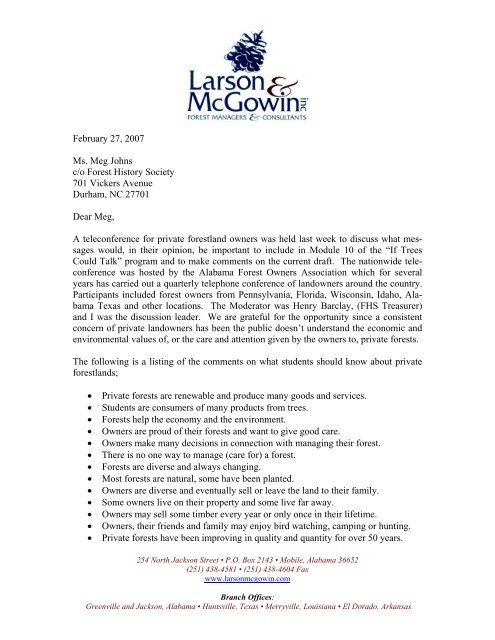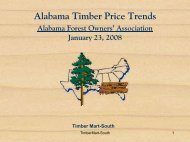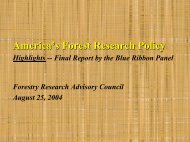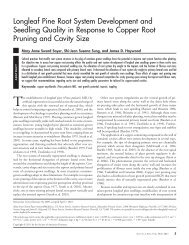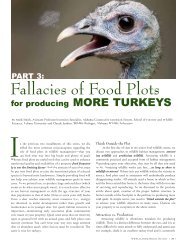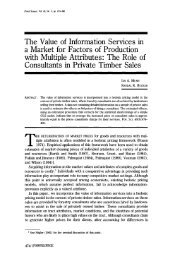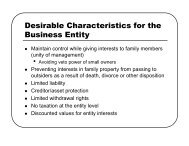Follow-up Comments by Keville Larson. - Alabama Forest Owners ...
Follow-up Comments by Keville Larson. - Alabama Forest Owners ...
Follow-up Comments by Keville Larson. - Alabama Forest Owners ...
- No tags were found...
You also want an ePaper? Increase the reach of your titles
YUMPU automatically turns print PDFs into web optimized ePapers that Google loves.
• The smallest tracts may not produce income, but have important value to the owners.• Most large tracts must be profitable for the owners to be able to keep and to manage.• Managing a forest is like managing a business or a farm.• It costs money to manage forestland.• <strong>Owners</strong> need advice from foresters, lawyers, accountants, bankers and others.• There are many sources of private business help and advice.The following few paragraphs have been written to further explain and to put commentsinto context;It is important to know that private forestland produces 92% of the trees used to make thethousands of products made from wood which every man, woman and child in the countryneeds or wants. In the process private forestland produces income to the owners whohave protected, managed and cared for those trees, and income for the millions of peopleemployed in the many steps involved in cutting, transporting, milling or manufacturing,selling and distributing wood and products we see and use every day, such as cardboardboxes, furniture or crossties.Some private forest properties are owned <strong>by</strong> one man or woman, others <strong>by</strong> several individualsor a family. Larger ones may be owned <strong>by</strong> a company or gro<strong>up</strong> of investors.Each one of them takes a great deal of pride in owning and caring for their forestland, butthere is a wide diversity in the forests and in their owners. Some own 5 acres, some own25,000 acres. Some are interested in growing trees to make paper, some to make lumberor telephone poles. Others are more interested in using their property for hunting or otherrecreation, or just to look like a park or be a natural area.There is no one management method suitable to the conditions and needs of the millionsof different forest ownerships. The kind of trees to grow and how often to cut them orthe kind of wildlife to be encouraged can vary and are decisions of each owner. The resultof many, many individual decisions has created a diverse and healthy mix or mosaicof ever changing forest conditions in the country as a whole. The 430 million acres ofprivately owned forestlands in the country as well as the 319 million acres owned <strong>by</strong> thestate or federal government constantly grow and change. <strong>Forest</strong>s are dynamic. They arechanged <strong>by</strong> natural forces such as hurricanes, fires, insect or disease outbreaks and theyare changed <strong>by</strong> actions of the owners. Yet nature always works to grow new trees. Treeplanting <strong>by</strong> man can quickly create a forest on open farm or pasture land. Replanting anarea where all the trees have been cut, can help establish the kind of new forest the ownerwants to have, Over 90% of the forestland in the U.S. is natural forest, About 7% ofU.S. forestland has been planted, some because of government programs designed to reducethe amount of farm land used for crops or to encourage wildlife or other environmentalvalues.254 North Jackson Street • P.O. Box 2143 • Mobile, <strong>Alabama</strong> 36652(251) 438-4581 • (251) 438-4604 Faxwww.larsonmcgowin.com
30 and only 1% were in classes over 30. The proportion of children in classes of 30 hassubsequently increased to 41% as average class size has risen.Projected increases in school age populationAnnual births in England have increased significantly since 2002, reaching levels last seen in the1970s. Births in 2010 were about 20% higher than in 2002, and 13% higher than in 2004.Consequently, p<strong>up</strong>il numbers are projected to increase. This increase has already been observedamongst the under 5s in maintained nurseries and primary schools, whilst the population ofprimary school children is projected to increase from 2010 until 2018. The secondary schoolpopulation is projected to continue to decline until 2015, before then rising as the increase in theprimary school population feeds through. At the Key Stage level, p<strong>up</strong>il population increases arealready being experienced in Key Stage One, which is projected to continue until 2015, whilst KeyStage 2 numbers are projected to have increased from 2011. P<strong>up</strong>il numbers in Key Stage 3 willincrease from 2014. Although the projected increases are expected across all regions, the changeis not uniform. For example, the rate of increase in the primary-aged population between 2010 and2015 is expected to be 5 percentage points higher in London than in the South West and the NorthWest.This suggests that the recent rise in births and subsequent increase in p<strong>up</strong>il numbers willinevitably have an impact on either the number of classes, teachers and classrooms, or classsizes and p<strong>up</strong>il teacher ratios, or a combination of both. Average class size is likely to rise unlessthe number of classrooms and the number of teachers is increased at a fast enough rate tocompensate for the projected increases. Furthermore, the relatively large proportion of Key Stage1 classes with around 30 p<strong>up</strong>ils means increased pressure on local authorities to ensure thatclasses do not exceed the legal maximum.How important is class size?Class size is clearly an emotive issue; 96% of parents believe that the number of children in aclass affects the quality of teaching and learning, whilst the falling P<strong>up</strong>il Teacher Ratio inindependent schools clearly illustrates market demand for smaller class sizes. Class size is thethird most common reason for parents choosing to send their children to independent schools.Teachers and head teachers also believe class size to be an important issue. A Danish studyfound that smaller class sizes in the early years of secondary school is associated with a smallincrease in the length of time a p<strong>up</strong>il spends in post-compulsory education.Class size does affect classroom procedures. Studies such as the Class Size and P<strong>up</strong>il AdultRatio (conducted <strong>by</strong> the Institute of Education between 2000 and 2003) and the Deployment andImpact of S<strong>up</strong>port Staff (DISS) have found that in smaller classes there is more active interactionbetween p<strong>up</strong>ils and teachers, p<strong>up</strong>ils have more individualised attention and p<strong>up</strong>ils are moreengaged, particularly those attaining at lower levels. In larger classes p<strong>up</strong>ils spend more timeinteracting with each other, teachers spend more time directly teaching the substantive content ofthe subject knowledge, and that more time is spent on administrative tasks. Teachers believed© Local Government Information Unit/Children’s Services Network www.lgiu.org.uk 22 UpperWoburn Place WC1H 0TB Reg Charity 1113495. This briefing available free of charge toLGiU/CSN subscribing members. Members welcome to circulate internally in full or in part; pleasecredit LGiU/CSN as appropriate.You can find us on Twitter at @LGiU


